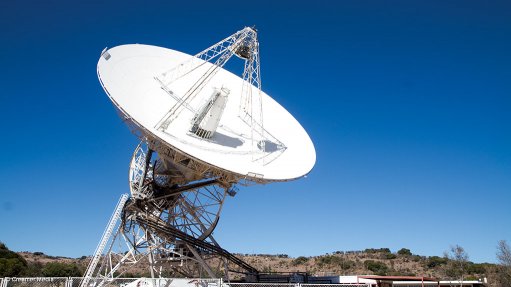
HartRAO’s 26 m radio telescope
Photo by: Duane Daws/Creamer Media
The South African government has endorsed the creation of a single national South African Radio Astronomy Observatory. This was done at the Cabinet meeting held on February 15 and reported in a statement released by the Government Communication and Information System (better known as GCIS) on Thursday.
“The concept of a single radio astronomy observatory, to be known as the South African Radio Astronomy Observatory, will consolidate the different projects and activities of the South African radio astronomy landscape,” affirmed the statement. “There are efficiency gains to be made with a single new National facility under the National Research Foundation.”
(The National Research Foundation is the country’s research and science development agency. It funds research, the training of top quality scientists and other researchers, and essential research infrastructure.)
Currently, South Africa has two separate radio astronomy institutions. The first of these is the Hartebeesthoek Radio Astronomy Observatory, west of Pretoria, with a 26-m-diameter radio telescope dish, a 15 m dish and a 7.5 m development and testing dish for the C-Band All Sky Survey (C-BASS) international radio astronomy programme.
A more recent establishment is SKA South Africa (SKA SA), responsible for South Africa’s participation in the international Square Kilometre Array (SKA) radio telescope project and for the design, construction and operation of the country’s SKA precursor radio telescope array, MeerKAT, as well as the small KAT-7 prototype array, in its reserve in the Northern Cape province. SKA SA also hosts South Africa’s operational C-BASS dish.
There was an entire section (2.4) of the communiqué devoted to radio astronomy programmes in South Africa. “Cabinet was briefed on the progress made in the Square Kilometre Array (SKA) and MeerKAT projects, the planned establishment of the merged South African Radio Astronomy Observatory, and the hosting of the Hydrogen Epoch of Re-ionisation Array (HERA) telescope on the SKA site,” the statement read.
The Cabinet noted that, “[g]ood progress is being made on the preparations for SKA-[Phase]1 in South Africa including the acquisition of land and negotiations on the international treaty and the procurement process. In its ten years the SKA SA Human Capital Development Programme has awarded over 800 bursaries, with extensive support to schools in Carnarvon [the town that is closest to the SKA SA reserve].”
It also hailed the MeerKAT, which produced its first image with only 16 of its planned 64 dishes, as “the best radio telescope in the Southern Hemisphere and should be the world’s best telescope of its kind, once completed.” All 64 dishes should be completed and operational by March next year, and the local content employed in the project comes to 75%.
HERA is another international programme being hosted by South Africa. It is largely funded by the US National Science Foundation and the University of Cambridge in the UK.